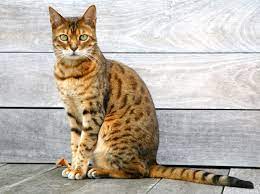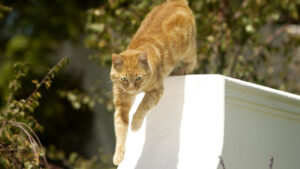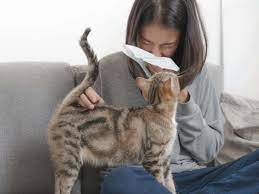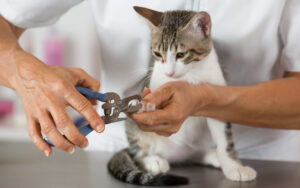
Characteristics: Bengals are lively and playful. They have a wild appearance and like playing with others.
Activity Level: Bengals are extremely active and demand a lot of playing as well as cerebral stimulation.
Grooming and Care: Their short coat requires little maintenance.
Family Friendly: Bengals are a fantastic choice for families, but their energy level may be too high for very small children.
Living Space: They thrive in larger houses with plenty of room for play and exploration.
Allergies: Bengals do not have hypoallergenic properties.

Characteristics: Scottish Folds are noted for their distinctive folded ears and pleasant, easy going demeanor.
Activity Level: They are moderately active and love playtime, but they are also satisfied resting.
Grooming and Care: Their short to medium coat requires little upkeep.
Family-Friendly: Scottish Folds make excellent family dogs, particularly in households with older children.
Living Space: They are versatile and may live in a variety of settings.
Allergies: They are not thought to be hypoallergenic.

Personality: Sphynx cats are noted for their hairless appearance as well as their inquisitive, sociable, and extroverted personality.
Activity Level: They are physically active and like playing and exploring.
Grooming and Care: Despite popular belief, Sphynx cats require regular bathing to maintain skin health.
Family Friendly: They are appropriate for families who are not turned off by their unconventional appearance.
Living Space: They adapt well to a variety of living environments.
Allergies: Due to their lack of fur, Sphynx cats may be a better choice for people who suffer from allergies.

Characteristics: Russian Blues are noted for their exquisite beauty and reserved but friendly personality.
Activity Level: They are physically active and like participatory play.
Grooming and Care: Because of their short, dense coat, they require little care.
Family Friendly: They can be ideal for families who prefer a more peaceful existence.
Living Environment: Russian Blues thrive in apartments and houses.
Allergies: Because of their lesser shedding, they may be healthier for people who suffer from allergies.

Personality: Abyssinians are lively, playful, and inquisitive cats. They like to be challenged mentally and physically.
Activity Level: They are very energetic and require a lot of exercise and play.
Grooming and Care: Their short coat requires little maintenance.
Family Friendly: Abyssinians can be good for families, although they can be too energetic for very young children.
Living Space: They thrive in homes with plenty of room to run and play.
Allergies: Abyssinians do not have hypoallergenic properties.

Characteristics: Burmese cats are friendly and outgoing, and they like connecting with their human friends.
Level of Activity: They are moderately active and enjoy interactive play.
Grooming and Care: Because of their short coat, they require less care.
Family-Friendly: Burmese cats are ideal for households with children.
Living Space: They adapt well to a variety of living environments.
Allergies: They are not thought to be hypoallergenic.
Making the Best Decision
Choosing the right cat breed is an important decision that can provide years of friendship and joy. This decision, however, should be made after careful consideration of your lifestyle, preferences, and the unique characteristics of various cat breeds. Here are some extra ideas to assist your quest of how to choose the right cat breed and ensure you make an informed and responsible decision:

Visit Shelters: Visiting local animal shelters and rescue organizations is one of the most rewarding ways to find your new feline friend. Countless cats in need of loving homes are frequently housed in shelters. These cats come from all walks of life and can be extremely affectionate and grateful companions. Many mixed-breed cats can be found in shelters and can be an excellent fit for a variety of lifestyles. Don’t underestimate the allure of a shelter cat; they have their own distinct beauty.

Talk to Breeders: If you determine that a specific purebred cat is the ideal fit for you, it’s critical to connect with responsible breeders who emphasize their cats’ health and well-being. Responsible breeders follow ethical breeding procedures and are concerned with the wellbeing of their feline friends. When speaking with breeders, inquire about the breed’s specific traits and characteristics, as well as any potential health issues associated with the breed. A reputable breeder will inform you about the cat’s ancestry, medical history, and any required vaccinations or health clearances.

Spend Time with the Cat: Before making a final decision, spend as much time as possible with a cat. Visit breeders, shelters, or foster homes to discover if the cat’s personality matches yours. Interacting with a cat in person can help you determine its temperament, energy level, and compatibility with your family. It’s a chance to watch their behavior and form an initial relationship.
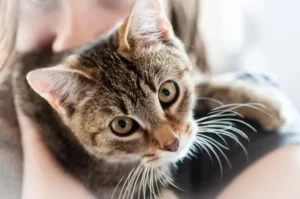
Consider Adoption: Adopting a cat is a wonderful experience. By giving a loving home to a needy cat, you not only gain a loyal companion but also contribute to animal welfare. Shelter cats, regardless of breed, can provide unconditional love and gratitude. When you rescue a cat, you form a special bond with them because you know you’ve given them a second chance at happiness.
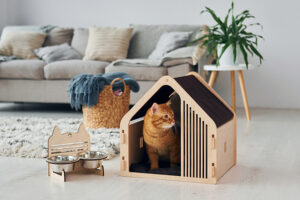
Prepare Your Home: Before bringing your new cat home, ensure that your living space is cat-friendly. Remove potential hazards that might harm your pet, such as toxic plants, chemicals, or small objects they might swallow. Provide essential supplies like litter boxes, scratching posts, toys, and cozy resting spots. Making your home safe and comfortable for your new cat will help them adjust and feel at peace in their new surroundings.

See a Veterinarian: All cats, regardless of breed, require regular veterinary care. Consult a veterinarian to ensure that you are completely equipped to meet your cat’s healthcare needs. Discuss immunization regimens, preventive care, and any health risks specific to the breed you select. Keeping your cat healthy and happy is a lifelong responsibility.

Patience and Commitment: Cats can live for 15 years or more, so be prepared to make a long-term commitment if you get a cat. It may take some time to form a deep bond with your cat, so be patient and persistent in your care and attention. You’ll develop a strong bond with your feline partner over time, one filled with love, trust, and innumerable cherished memories.
FAQs
What are the essential elements to consider when choosing a cat breed for my lifestyle?
You should consider aspects including your activity level, dwelling space, allergies, family status, job schedule, and grooming and maintenance preferences when choosing the right cat. These elements will help you pick a cat that fits nicely into your daily life.
What is the distinction between purebred cats and mixed-breed cats?
Purebred cats are the result of selective breeding for specific breed standards, and their characteristics are frequently predictable. Mixed-breed cats lack breed criteria and exhibit a wide range of features dependent on their ancestors.
Are hybrid cats suitable for households?
Hybrid cats are the offspring of domestic cats and wild cat species, and they can have distinct appearances and behaviors. They may be appropriate for some households, but their unique demands and traits must be carefully examined.
Which cat breeds are thought to be hypoallergenic?
While no cat is completely allergy-free, certain breeds are thought to be more allergy-friendly than others. Because of their decreased shedding and allergenic protein levels, breeds like the Russian Blue and Sphynx may cause fewer allergic reactions in some people.
After adopting or acquiring a cat, how can I ensure its health and well-being?
All cats require regular veterinary care. Consult a veterinarian to ensure that you are completely equipped to meet your cat’s healthcare needs. Discuss immunization regimens, preventive care, and any health risks specific to the breed you select.
Is it preferable to adopt a cat from a shelter or to buy one from a breeder?
Both options have advantages. Adopting a shelter cat ensures a loving home for a cat in need, regardless of breed. Buying from a reputable breeder can provide greater certainty in terms of breed features and ancestry. The decision is based on your preferences and priorities.
Before adopting or acquiring a cat, how can I know if its personality matches my expectations?
Spend as much time as possible with the cat before making a final decision. Interact with the cat at breeders, shelters, or foster homes to assess its temperament, energy level, and suitability for your family.
Can I give a caring home to an allergic cat in my household?
Yes, hypoallergenic cat breeds such as the Sphynx and Russian Blue may be a better option for households with allergy sufferers. Regular grooming and keeping a clean living environment can also aid in the reduction of allergic reactions.
Is a huge living space required to accommodate specific cat breeds?
The breed’s level of activity determines how much space a cat needs. Larger living spaces may suit more active breeds, such as Maine Coons, although less active breeds, such as Persians, can adapt well to smaller homes or apartments.
How long should I expect a cat to live, and what is the time commitment?
Cats can live for up to 15 years, so be prepared to make a long-term commitment. It may take some time to form a deep bond with your cat, so be patient and persistent in your care and attention. You’ll develop a strong and lasting bond with your feline buddy over time.
Conclusion
Choosing the best cat breed for your lifestyle is a big decision that will have a big impact on both your life and the life of your new feline buddy. When making this decision on how to choose the right cat breed, consider your daily routine, living situation, and personal preferences. Remember that all cats, regardless of breed, deserve love, care, and a forever home, so make your decision with the intention of giving your new pet the best life possible. Whether you choose a purebred or a mixed-breed cat, it will definitely provide you with a lifetime of love, joy, and companionship.



































































































































